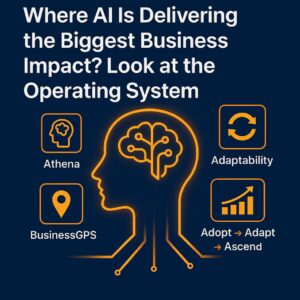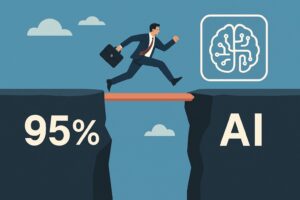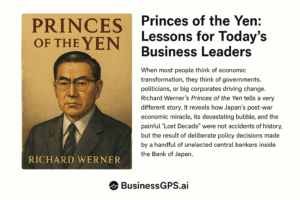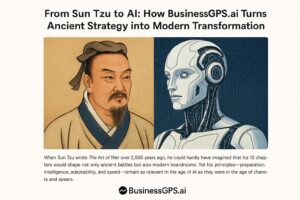
Adaptability as a Competitive Advantage: How AI is Rewiring Business Transformation

Adaptability Wins - Emergent New Capabilities Through AI
In today’s volatile market, research consistently shows that companies with adaptability embedded in their culture tend to thrive faster and survive longer than less agile peers. McKinsey finds that organizations with strong cultures of adaptability deliver significantly better financial performance than those that lack such traits ( mckinsey.com ).
During times of crisis, resilient (highly adaptable) companies not only recover faster but even outperform competitors– for example, during the 2008–09 financial crisis, resilient firms generated about 20% higher shareholder returns than their less adaptable peers ( mckinsey.com ).
It’s no surprise, then, that investors reward adaptability: during market downturns, investors “pay up” for companies viewed as resilient in their response ( esg-reporting.uwaterloo.ca.)
In short, the ability to rapidly adjust and innovate in the face of change has become a key predictor of long-term success and investor confidence in an ever-changing market.
AI-Powered Transformation of Strategy and Execution
Artificial intelligence is reshaping how businesses strategize, execute, and manage change. Whereas strategy used to rely heavily on human-driven analysis and slow iterative planning, AI-driven tools are accelerating and enhancing every phase of this process. McKinsey observes that AI can now augment each stage of strategy development – from initial design and analysis through mobilization and execution – helping organizations allocate resources, monitor progress, and adapt plans in real-time ( mckinsey.com ).
This means strategy execution and change management can become more data-driven and responsive, reducing the lag between insight and action.
Beyond internal planning, AI is also transforming business models at a fundamental level. Harvard Business Review notes that a new breed of AI-centric companies (from tech giants to digital natives) operate with algorithms at their core, freeing them from traditional operating constraints and enabling unprecedented scalability ( keystone.ai ).
AI-driven processes can be scaled up rapidly and continuously improved, allowing such firms to overtake traditional competitors by competing in ways previously impossible ( keystone.ai ).
In practice, this means leveraging AI not just for efficiency, but to reinvent products, services, and customer experiences at speed. The net effect is that companies harnessing AI for strategy and execution are often more agile, innovative, and competitively positioned – effectively using AI as a catalyst for business transformation rather than just a technical tool.
Consulting Firms Embracing AI-Powered Platforms
Leading consulting and advisory firms are themselves undergoing a transformation in service delivery, shifting from traditional manpower-intensive, day-rate consulting toward AI-powered platforms that boost efficiency and impact. Instead of solely billing hours, top firms are investing in proprietary technology platforms that productize and augment their consulting services. Notable examples include:
- KPMG – Velocity Platform: KPMG recently announced “Velocity”, an AI-enabled business transformation platform that unifies its consulting methods, tools, and AI capabilities into one suite ( kpmg.com ).
The platform combines KPMG’s extensive transformation frameworks with AI-driven analytics to accelerate change delivery. By integrating proven methodologies with intelligent tools, KPMG Velocity empowers its consultants to design and execute client transformations smarter and faster than the traditional purely manual approach ( kpmg.com ).
The goal is to enhance service precision and speed, allowing clients to see results sooner.
- IBM – Consulting Advantage: IBM has rolled out an AI services platform called “IBM Consulting Advantage” to support its 160,000 consultants globally ( techmonitor.ai. ).
This platform features generative AI assistants that help with tasks like data analysis, business case development, code generation, and more – essentially acting as “digital consultants” alongside human teams ( techmonitor.ai. ).
Early trials showed these AI assistants boosted consultant productivity by up to 50%, a massive efficiency gain ( techmonitor.ai. ).
IBM’s COO describes generative AI as “the most fundamental shift in the consulting model in decades,” enabling the firm to deliver greater value faster to clients by harvesting its knowledge into AI tools ( techmonitor.ai. ).
In short, IBM is augmenting its consulting workforce with AI to improve consistency, reduce project timelines, and enhance outcomes.
- EY – Transformation Platform: EY has developed the EY Transformation Platform, a central digital platform to streamline the entire transformation journey for clients. It creates a “digital pathway from strategy to execution,”leveraging EY’s technology and business knowledge with proprietary tools ( ey.com ).
This platform helps organizations set clear objectives and harness data for actionable insights, effectively connecting high-level strategy with hands-on execution ( ey.com ).
By embedding analytics and AI, EY’s platform aims to make transformations more guided and measurable, improving the success rate and efficiency of change programs.
This industry trend illustrates a broader point:
consulting firms are “eating their own dog food” by using AI and digital platforms to transform their own operations. These platforms standardize best practices, provide real-time insights, and automate repetitive analyses – enabling consultants to focus on high-value activities (like problem-solving and client collaboration) while the software accelerates data crunching and project management. The result is a consulting approach that is more scalable, efficient, and consistently delivered, moving away from purely bespoke, labor-intensive engagements toward technology-augmented partnerships with clients.
AI Tools Aligning Consultants and Client Teams
Crucially, these AI-driven transformation platforms are not just internal productivity boosters; they also enhance collaboration with client teams and support client-side execution. The new model blurs the line between consultant and client activities by providing shared tools and data that everyone can leverage. For instance, KPMG’s platform was built as “one transformation environment for our clients” – it integrates all of KPMG’s digital transformation capabilities into a single ecosystem that clients can access, thereby increasing the speed, agility, and confidence with which clients themselves can move forward on initiatives ( kpmg.com ).
Rather than handing over a static report, KPMG delivers a live platform where client stakeholders and KPMG advisors work in sync, ensuring each step of the change journey is transparent and on-track. This kind of tool gives clients more ownership and visibility into the transformation, aligning efforts and reducing miscommunication.
Other firms echo this collaborative, tool-enabled approach. Bain & Company, for example, developed ARC℠ (Action Results Collaboration) – a proprietary change-management software designed to keep transformation projects on track. ARC is described as “a transformation management tool that’s fast, flexible, and secure” for effective tracking of initiatives ( bain.com ).
The emphasis on “Collaboration” in its name underlines that it’s meant to be used jointly by consulting teams and client teams to monitor progress, adjust actions, and ensure accountability. As Bain notes, successful business transformations are “about continuously reshaping an organization” and, when done right, they “enhance performance, increase efficiency, and create a competitive advantage.” (bain.com ).
Providing a digital tool to orchestrate this continuous change helps both consultants and clients stay aligned on goals, metrics, and responsibilities throughout the process.
In essence, AI-powered transformation tools like these function as a GPS for business change – much like the BusinessGPS approach – guiding all parties through the complex roadmap of strategy execution. They offer real-time insights (so adjustments can be made promptly), democratize data (so client leaders can make informed decisions alongside consultants), and embed best practices (so even client teams with less transformation experience can follow a proven path). This collaborative use of AI tools ensures that change initiatives don’t live in a consultant’s spreadsheet alone, but are actively managed and owned by the client organization as well. The outcome is a higher likelihood of lasting change taking hold, with skills and systems that remain in place after the consultants depart.
Validating the AI-Driven Transformation Model
The trends and evidence above directly validate the key ideas behind BusinessGPS’s model of AI-driven transformation. Traditional change efforts have a notorious failure rate – studies have long shown that roughly 70% of business transformations fail to meet their objectives ( mckinsey.com ).
Contributing factors include unclear direction, poor internal engagement, and difficulty sustaining momentum ( mckinsey.com ).
The BusinessGPS philosophy addresses these pain points head-on by using AI and structured frameworks to make transformation more transparent, data-guided, and continuous (rather than one-off or “vendor-driven”). This approach is firmly supported by industry research and expert opinion:
- Adaptability and Continuous Improvement: BusinessGPS emphasizes building adaptability and turning external changes into opportunities, which is in line with expert views that continuous organizational learning is the only way to “thrive beyond” disruptions rather than just survive them ( mckinsey.com ).
Companies that embrace this mindset of ongoing adaptation enjoy better performance and competitive longevity, as noted earlier. They effectively future-proof themselves, which is exactly the outcome BusinessGPS targets for clients.
- AI-Driven Decision Support: The model’s use of AI agents and analytics to guide decisions finds strong support in the literature. By augmenting human teams with AI, organizations can remove bias, illuminate patterns in data, and accelerate execution. McKinsey calls this moment a new inflection point, where AI can supercharge strategy execution and change implementation across the board ( mckinsey.com ).
HBR’s analysis further underscores that those who leverage AI at the core of their operations can unlock nonlinear growth and outperform peers that stick to traditional methods ( keystone.ai. )
This affirms that BusinessGPS’s AI-centric platform is not just tech for tech’s sake, but a source of genuine competitive advantage.
- Platform and Tool-Based Execution: The pivot from ad-hoc consulting to a platform-based, tool-enabled transformation aligns with what top consultancies are doing, as seen with KPMG, EY, IBM, and Bain. BusinessGPS’s framework and AI tools operate in a similar vein – providing a repeatable process and digital assistance to manage change. This approach has been shown to improve speed, efficiency, and success rates of transformations. For example, KPMG’s AI platform is explicitly designed to eliminate inefficiencies and keep every step “in sync” with long-term goals ( kpmg.com ).
Such alignment and consistency are exactly what BusinessGPS promises by giving clients a clear roadmap (27-step framework) supported by AI guidance. It ensures that the transformation is not left to chance or fragmented efforts, but is continuously steered towards the desired outcomes.
- Empowering Clients and Teams: A core tenet of BusinessGPS is making transformation accessible and governable – essentially empowering client teams to drive change with expert AI guidance rather than relying wholly on external consultants. The shift we see in consulting industry supports this empowerment. IBM’s COO noted that using their AI platform makes consultants “more creative and productive” and helps deliver value faster to thousands of clients ( techmonitor.ai ) indicating scalability and consistency. In practice, this means more organizations (not just the largest ones) can benefit from top-tier transformation practices. BusinessGPS’s mission to “de-risk change and make transformation achievable for any SMB” echoes this democratization of expertise ( businessgps.ai. )
By validating that even big firms are packaging their know-how into AI tools, we reinforce the credibility of BusinessGPS’s similar model for smaller businesses.
Trajectory of the AI-Driven Transformation Model
The current wave of AI-powered transformation solutions from leading consultancies like KPMG, IBM, Bain, and EY represents a crucial shift towards more agile, tool-supported business transformations. These firms recognize that the complexity and pace of change require sophisticated digital platforms to orchestrate strategy and execution effectively.
However, despite the powerful capabilities these platforms offer, they primarily enhance the productivity and efficiency of the consulting firms themselves. Clients, particularly SMBs, still face the fundamental challenge of fully leveraging and integrating these advanced systems into their operations without becoming dependent on external consultants.
This gap creates a clear market need: a client-centric platform that not only provides access to sophisticated transformation capabilities but fundamentally empowers organizations themselves—enabling them to independently manage, own, and sustainably drive their transformation journeys.
This is precisely where BusinessGPS.ai sets itself apart.
BusinessGPS goes beyond simply augmenting consulting capabilities—it empowers client-side teams directly. By harnessing the foundational principles validated by leading firms like KPMG, IBM, EY, Bain, and McKinsey, BusinessGPS creates a unified client-centric platform. Our unique Opportunity to Operations (O2O) process acts as the universal stitching mechanism, seamlessly integrating specialized AI-enabled transformation tools from various vendors and internal solutions into one coherent, client-owned ecosystem.
This approach bridges a critical gap in the transformation landscape. Instead of relying solely on consultants' proprietary tools or fragmented internal project-management solutions like Jira, organizations now have their own comprehensive, AI-augmented transformation management system. It serves as their internal engine for continuous adaptation and strategic alignment—enabling SMBs to efficiently orchestrate multiple vendor systems, manage complexity, and execute change initiatives without continuous external dependency.
In essence, BusinessGPS provides a missing link: a client-controlled, method-driven, AI-powered platform that enables organizations not just to adopt change methodologies but to sustainably own and adapt them. This positions SMBs uniquely to thrive—accelerating their transformation journeys, increasing investor attractiveness, and future-proofing their operational agility in ways previously accessible only to the largest enterprises.
In short, BusinessGPS doesn't just level the playing field—it redefines the rules, placing the power of ambidextrous transformation directly in the hands of the client.
Ultimately, the competitive advantage of AI-powered business change is clear. Companies that leverage AI to become more adaptable, that use data-driven platforms to execute strategy, and that foster collaboration through technology, are consistently outperforming their peers on multiple fronts. They react faster to market shifts, execute with greater precision, and sustain improvements over time. The authoritative sources – from McKinsey and Bain to HBR and Gartner peers – all point to the same conclusion: embracing an AI-driven transformation model is rapidly becoming not just an option, but a prerequisite for thriving in a fast-changing business landscape. This lends considerable weight to the BusinessGPS approach, as it is built on principles now proven and adopted by leading organizations worldwide. The model isn’t speculative; it’s the logical next step in how companies big and small will plan and implement change to stay ahead of the curve.
Sources: McKinsey, Harvard Business Review, KPMG, IBM, EY, Bain & Company, et al. (as cited above)





